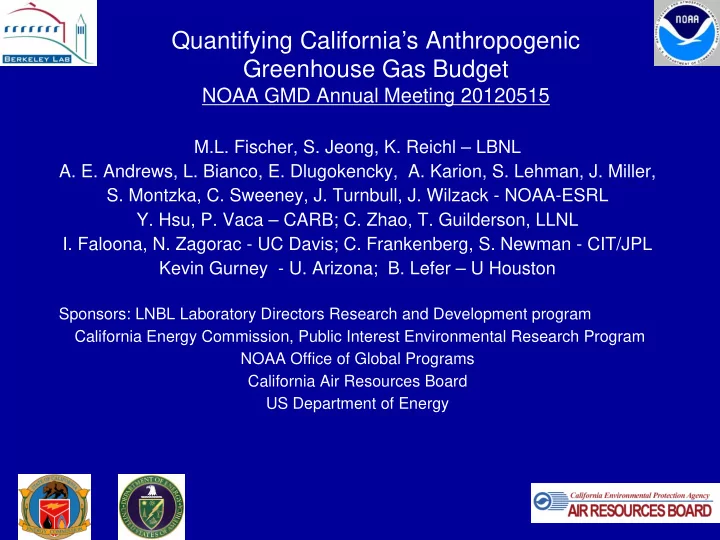

Quantifying California’s Anthropogenic Greenhouse Gas Budget NOAA GMD Annual Meeting 20120515 M.L. Fischer, S. Jeong, K. Reichl – LBNL A. E. Andrews, L. Bianco, E. Dlugokencky, A. Karion, S. Lehman, J. Miller, S. Montzka, C. Sweeney, J. Turnbull, J. Wilzack - NOAA-ESRL Y. Hsu, P. Vaca – CARB; C. Zhao, T. Guilderson, LLNL I. Faloona, N. Zagorac - UC Davis; C. Frankenberg, S. Newman - CIT/JPL Kevin Gurney - U. Arizona; B. Lefer – U Houston Sponsors: LNBL Laboratory Directors Research and Development program California Energy Commission, Public Interest Environmental Research Program NOAA Office of Global Programs California Air Resources Board US Department of Energy
Outline • Problem: Direct GHG emission measurements crucial for sound energy and environmental policy • Approach: Quantify regional GHG emissions across California using atmospheric inverse estimation • Results: Now capture major portions of CA GHG budget – Fossil CO 2 consistent (~ 10%) with CARB inventory – CH 4 & N 2 O significantly greater than CARB inventory – Central CA HFC134a emissions overestimated in EDGAR4.2 • Conclusions: Current inventory requires revision • Future Work: Considerations for new sites in Southern California 2
Non-CO 2 GHG Emissions • California initiated GHG emission controls (AB-32) – Fossil fuel CO 2 dominant source • Non-CO 2 sources not readily metered – Some sectors have CEC, 2006 uncertainties 10 to > 100% (NRC, 2010) • Atmospheric inverse method provides independent check CARB, 2010
Approach Emission Measurements Measurements Model calgem.lbl.gov Emission Emission Estimate Estimate
Meteorological Model for California • Weather Research Forecast (WRF) Model Domain set-up – Two-way nesting WRF in five Monthly mean PBL (10:00 local), June domains to 1.3 km 2008 – 5-layer irrigated land model • Evaluation with radar-wind profilers – PBL depth – Winds Wind profilers : Chico (CCO), Sacramento (SAC), Livermore (LVR), Chowchilla (CCL)
Model-Measurement Uncertainty WRF-STILT versus SAC Profiler PBL Depth • Quantify error sources • Propagate errors through modeling system to provide quantitative uncertainties – Boundary layer ~ 20-45 % – Wind Velocity ~ 10% – GHG background ~ 10-40 % – Inventory resolution ~ 10 % – Other ~ 10% • Quadrature sum ~ 30-50% of signal for individual time points 6
Fossil Fuel CO 2 at Walnut Grove CO (ppb) CH 4 (ppb) CO 2 (ppm) • Measured CO 2 , CO enhancements (green, red) above background (black) capture regional emissions • ffCO 2 from1 year (Mar, 2008- Feb, 2009) radiocarbon 14 CO 2 flask data •Continuous ffCO 2 from CO and 14 CO 2 :CO ratio
Fossil Fuel CO 2 Emissions Spring Summer • Predicted ffCO 2 calculated with Vulcan 2.0 and footprints • Comparison of predicted and measured daytime signals • Slopes consistent with Fall Winter unity +/- ~ 10 % at WGC • Similar result obtained for May-June, 2010 data from CalTech
CH 4 Emissions • CH 4 Tower Network 2010 – 2011 Sutter Buttes WGC Madera • Central Valley towers Tranquility Arvin constrain ~ 90% of CA model CH 4 emissions • Posterior emissions 1.6 ± 0.1 times CARB inventory • Observed seasonality in some regions indicative of underlying processes
N 2 O Emissions • Two years (2008 – 2009) Walnut Grove data • Central CA emissions 2.1 ± 0.4 x EDGAR4.2 • If spatial distribution follows EDGAR then actual N 2 O emissions 2.7+/ ‐ 0.5 times California 2012 inventory • N2O may constitute ~ 10 % of total CA GHG emissions (Jeong et al., submitted ) EDGAR4.2 EDGAR3.2 WGC WGC
HFC-134a Emissions • 2 Years (2008-2009) Walnut Grove data • If EDGAR captures spatial pattern, actual emissions ~ 0.6 x CARB inventory (CARB, 2012) • Without significant seasonal variation EDGAR4.2 HFC-134a Emission Map pmol m -2 s -1
Conclusions • Atmospheric measurements and inverse modeing provide a powerful independent constraint for emissions inventory validation – Fossil CO 2 consistent (~ 10%) with CARB inventory – CH 4 & N 2 O significantly (1.5-3 x) greater than CARB inventories – HFC134a appears overestimated in CARB inventory (1.4x) for Central CA • Coming efforts: – Continuous VOC (w/ UCB) & N 2 O at WGC O, CO, 14 CO 2 – GHG (CO 2 , CH 4 , N 2 ) measurements (w/ CIT & CARB) at Riverside/San Bernardino tower – WRF modeling (w/ EN & UCSD) for SoCal urban region 12
GHG Tower for Riverside/San Bernardino • Evaluating WRF at three S.Cal USC ONT profiler sites • WRF captures daytime PBL for May-June, 2010 Los Angeles ONT USC Riverside MRV MRV
14 Thank You
Recommend
More recommend